When we woke after a good night’s sleep, it was a treat to not have to hurry anywhere right away, even though we still had to get ready to check out of the hotel that morning. The breakfast café next door was open this time—no doubt because we arrived about half an hour later than we had on Friday. We had plenty of time to enjoy a nice breakfast before checking out and stashing our luggage in the hotel’s courtesy storage room. We hadn’t used that for our big bags while we were on the Nutshell tour because we weren’t sure how secure it would be if we left it overnight. Today, we just needed to leave it for a few hours while we went to church and did a little more sightseeing around Oslo.
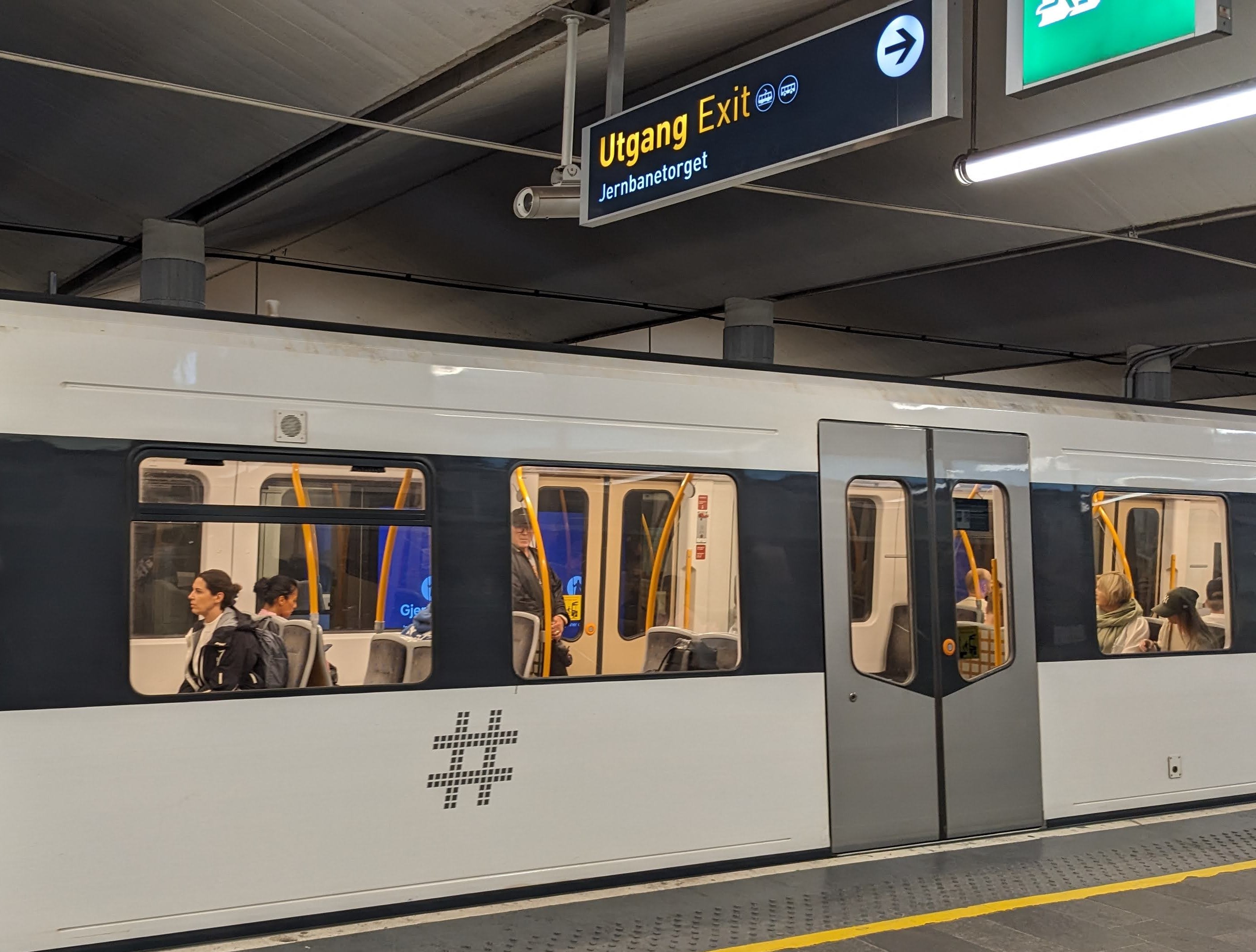
Oslo subway
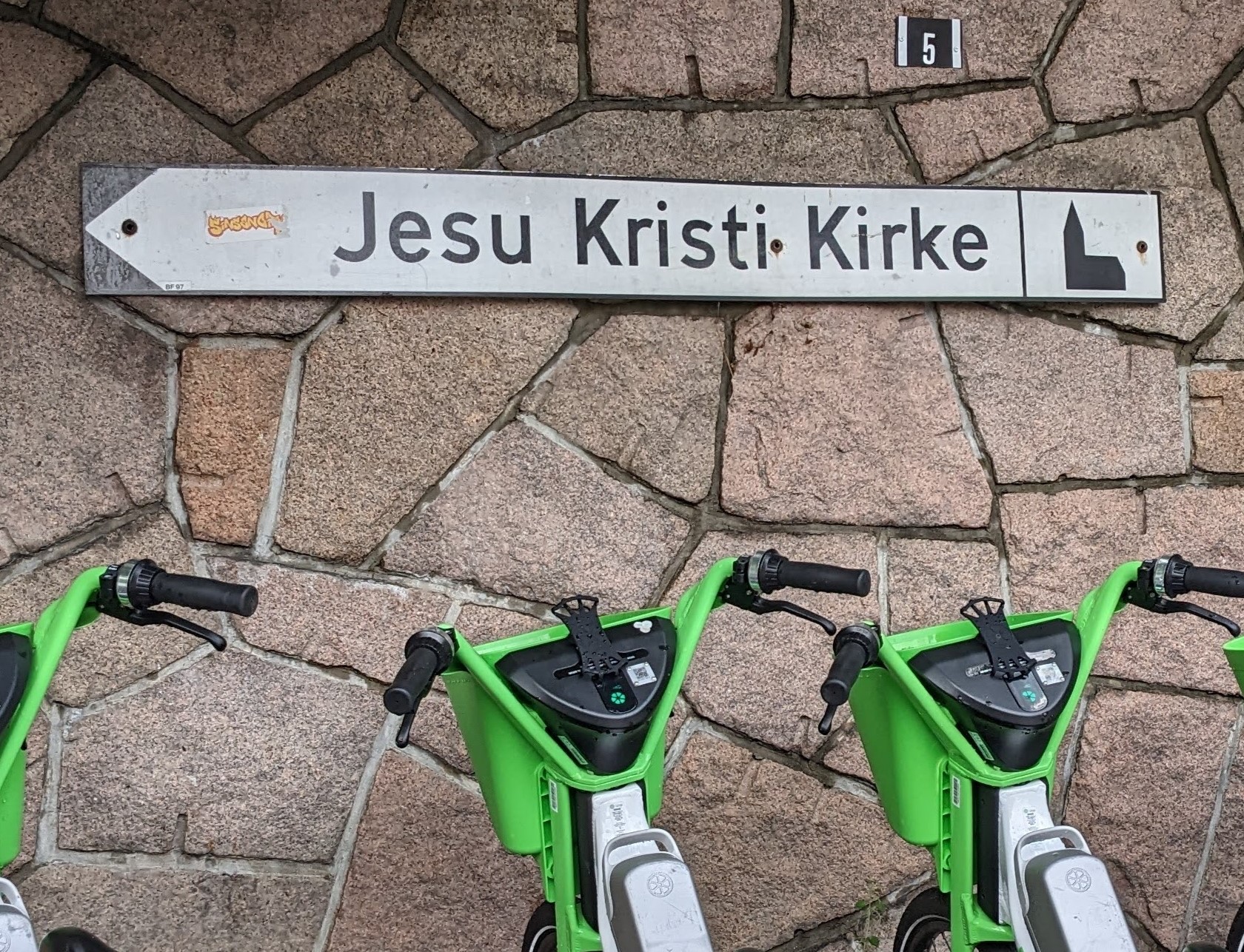
An unexpected but welcome sign showed us the way to church
Michael had obtained the address and meeting time of the Oslo Ward of The Church of Jesus Christ of Latter-day Saints, and had determined that we could get there on the subway, but he wasn’t sure how often the subway cars ran on Sunday, nor exactly how long the trip would take, so he made sure we left for Jernbanetorget (Railway Square, where we would board the subway) an hour before sacrament meeting was scheduled to start. The walk from Citybox to Jernbanetorget took less than five minutes, and the ride to Carl Berners Plass less than fifteen—so far, so good. But how would we know which exit to use from the subway station, and which direction to go from there? All we could do was guess. The Lord must have been watching over us, however, because as soon as we emerged from the underground station, we saw a sign that said: “Jesu Kristi Kirke,” with an arrow pointing up the street to our left. (Apparently we were not the first LDS visitors to wonder how to find the church building after getting off the subway.)
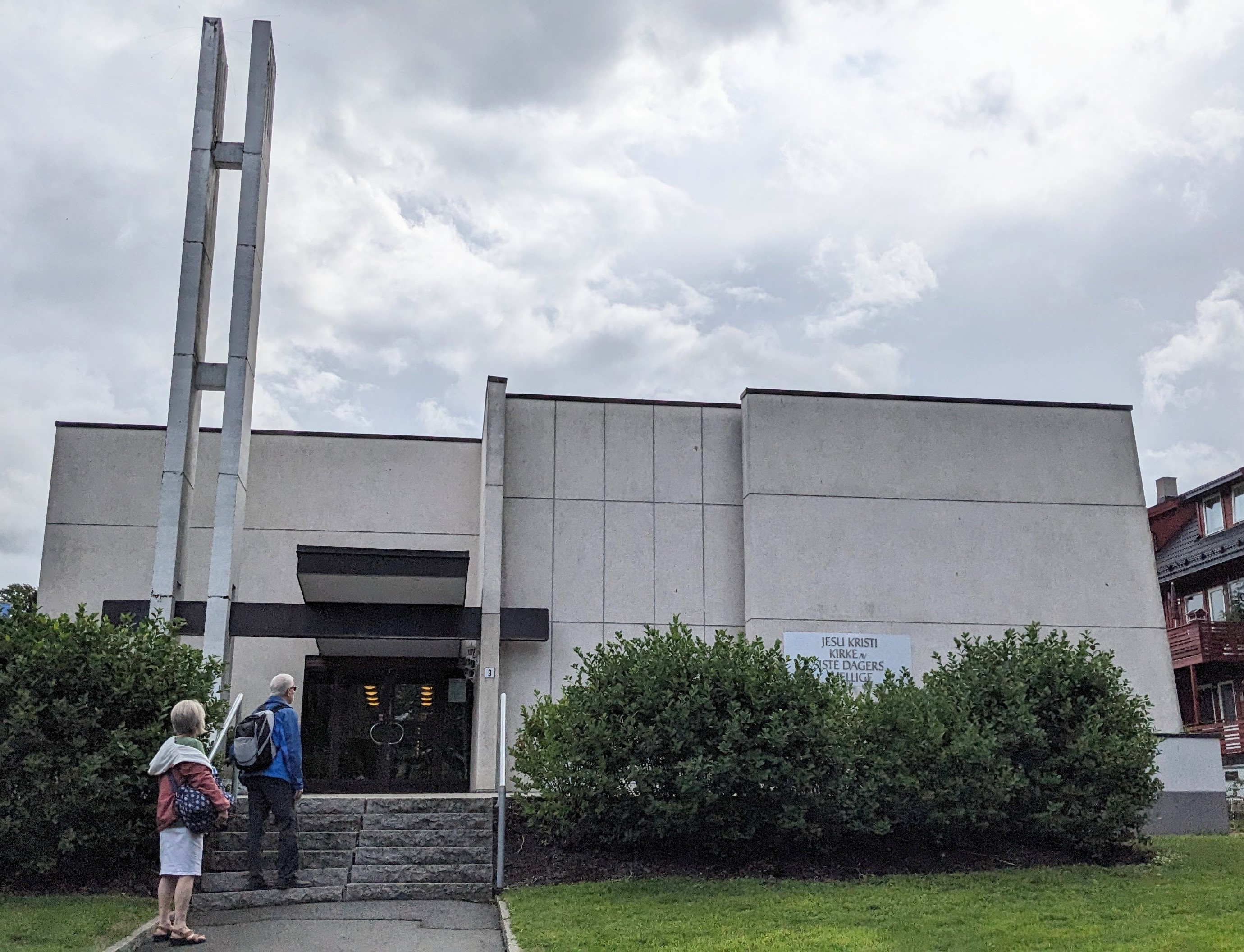
The Oslo Ward’s meetinghouse
Although we arrived quite early, a steady trickle of people were moving through the foyer. Nancy took the opportunity to sit and delete old email messages (needing to free-up space in her dwindling online storage), while Michael and Pat chatted up ward members and other visitors until it was time for the meeting to begin. They also secured headsets so we could listen to the English translation provided by the missionaries. After the sacrament was administered, the first speaker was one of the sister missionaries, who spoke in Norwegian about Christ and the Atonement. The second speaker was a man from Brazil, who had arrived at church with his young son on a motorized scooter. He spoke in English, describing his experiences with the Church in Brazil, and telling how the gospel had informed all his major life decisions—including the one to emigrate to Norway. The young missionary sister who had been semi-successfully providing English translation for us while her companion spoke suddenly looked panic-stricken when a member of the congregation asked if she would also translate the Brazilian’s English into Norwegian. She tried tackling translation in reverse but gave up after only a few minutes, giggling embarrassed apologies to the non-English speakers. We felt her pain. We had joined in the congregational hymns, singing the familiar melodies with confidence but with no idea how to pronounce most of the Norwegian words.
We did not stay for the second-hour meetings, taking the subway back to Oslo Senter. We now had the challenge of finding somewhere to go for lunch. We still had a few hours before we had to be at the airport for our flight back to Paris, so we hoped to find a restaurant where we could sit and have a leisurely meal, preferably inside because it was wet and blustery again, and preferably one that served Norwegian cuisine. (“I’d really like to try reindeer,” Pat said.) Curiously, the only actual sit-down restaurants we could find were Italian, which we didn’t particularly want because we had already eaten at an Italian restaurant in Oslo. There were a few sandwich shops, but those didn’t sound appealing because we expected that we would have to get sandwiches to eat on the plane. Adding to our challenge was the fact that many places were closed on Sundays. Los Tacos was open so we walked in, but after looking at the menu on the wall, decided we didn’t really want Mexican, either.
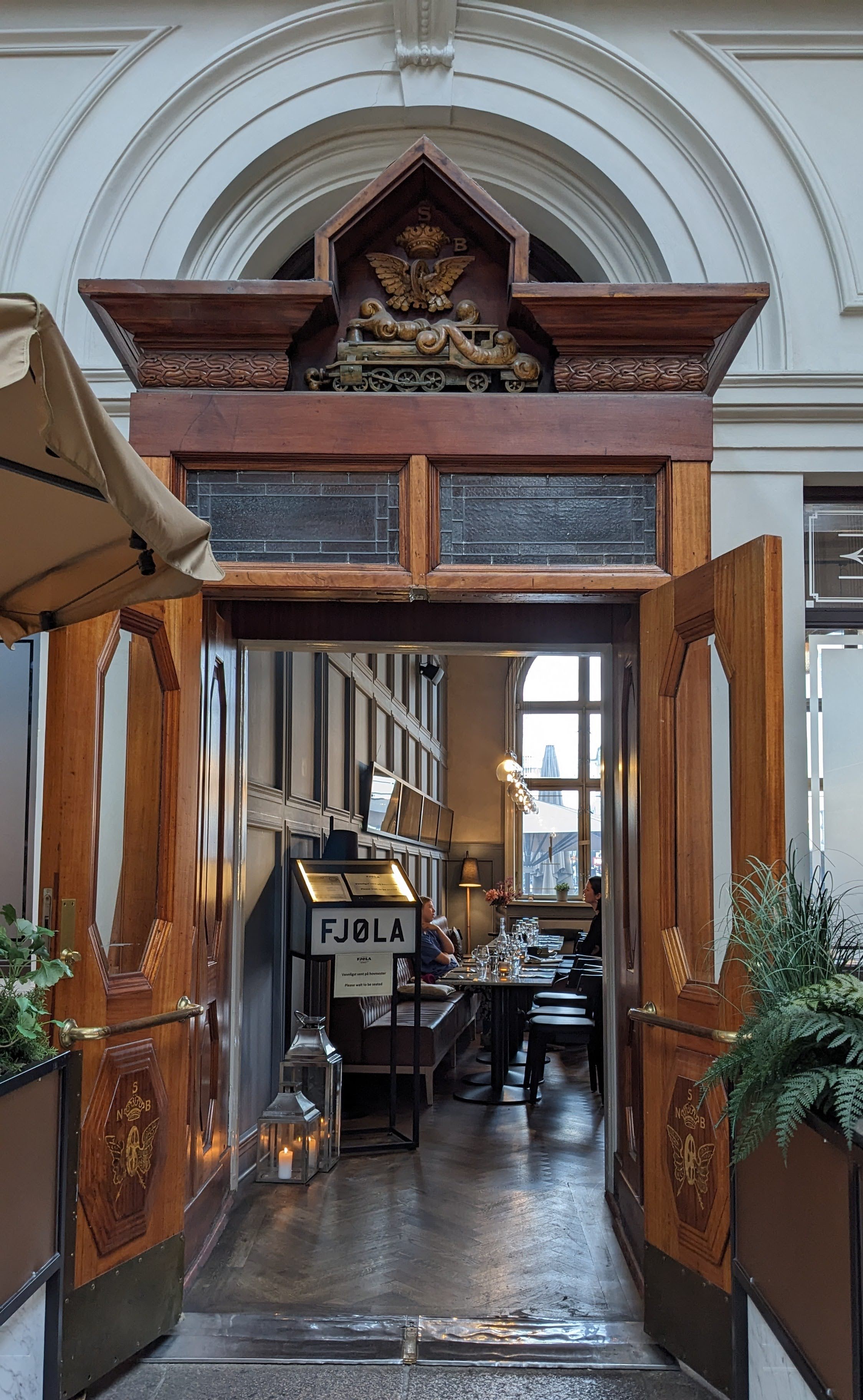
Fjola: Translated into English, the name means “Fool”
Next to Los Tacos was a hotel, so Nancy decided to go in and ask the desk clerk for recommendations. “We’re looking for a place where we can sit down for a not-too-expensive traditional Norwegian meal, but all we seem to find are Italian restaurants.”
The clerk smiled wryly and said, “Yes, we do love our pasta!” But then she suggested that we go to the old train station—now transformed into a shopping mall and food court—and eat at Fjola. Although the menu posted near the door didn’t look terribly interesting (much like that of a TGI Friday’s, but more limited) we realized that this was probably our best choice, so we went inside. It was lunchtime, but nearly all the tables were empty—not an auspicious sign.
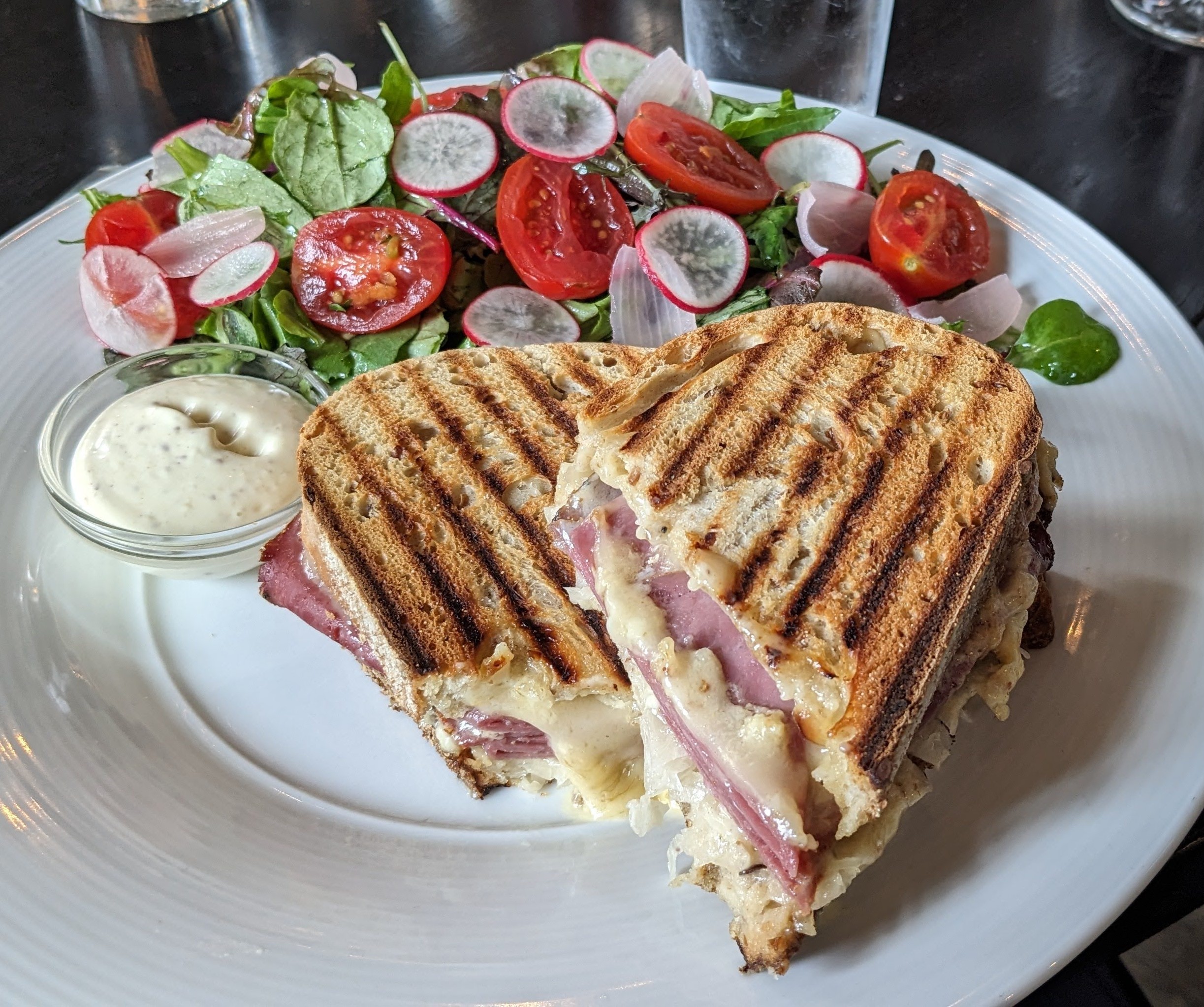
Fjola’s rendition of a Reuben
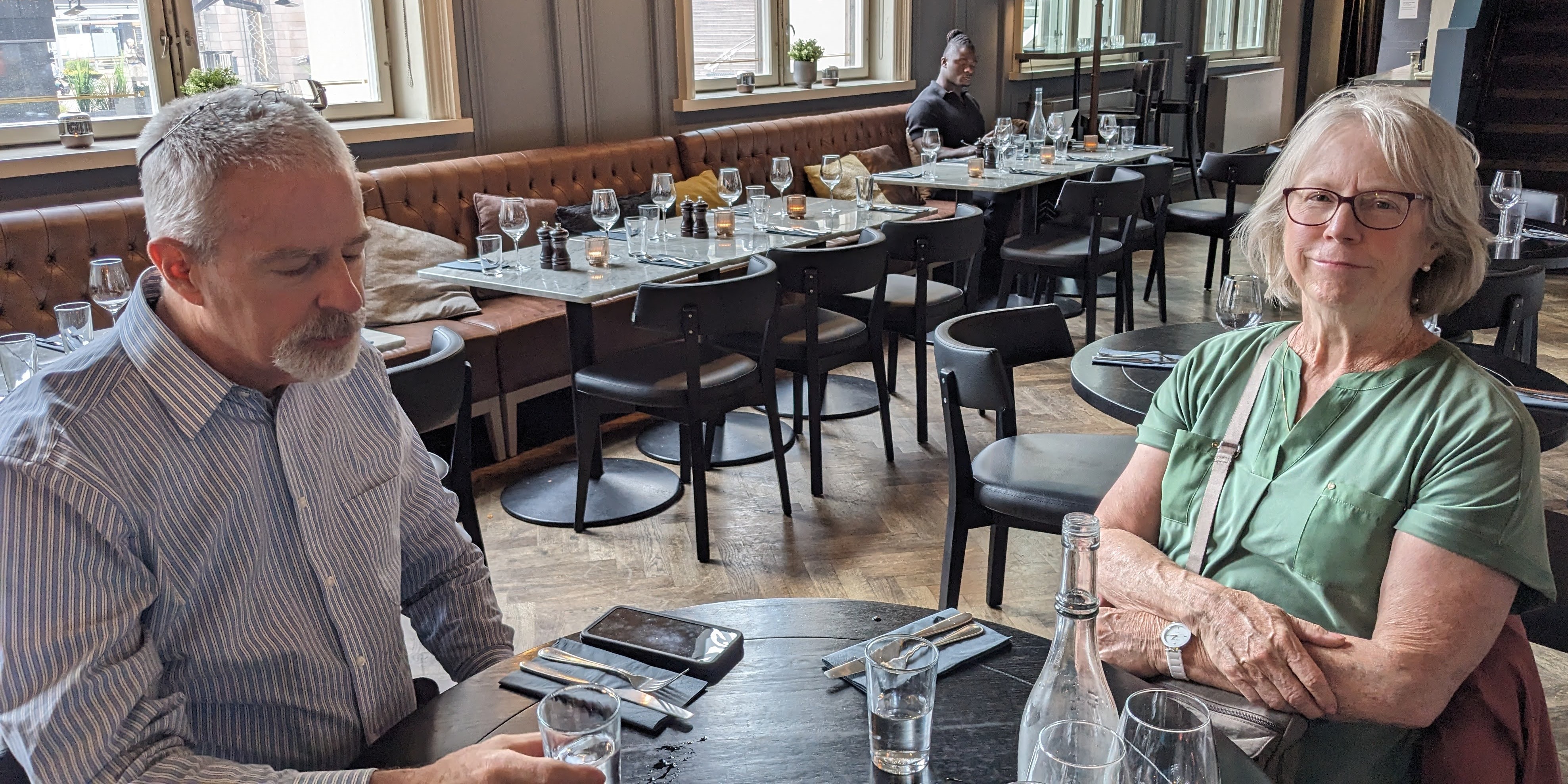
Michael and Pat relaxing in Fjola
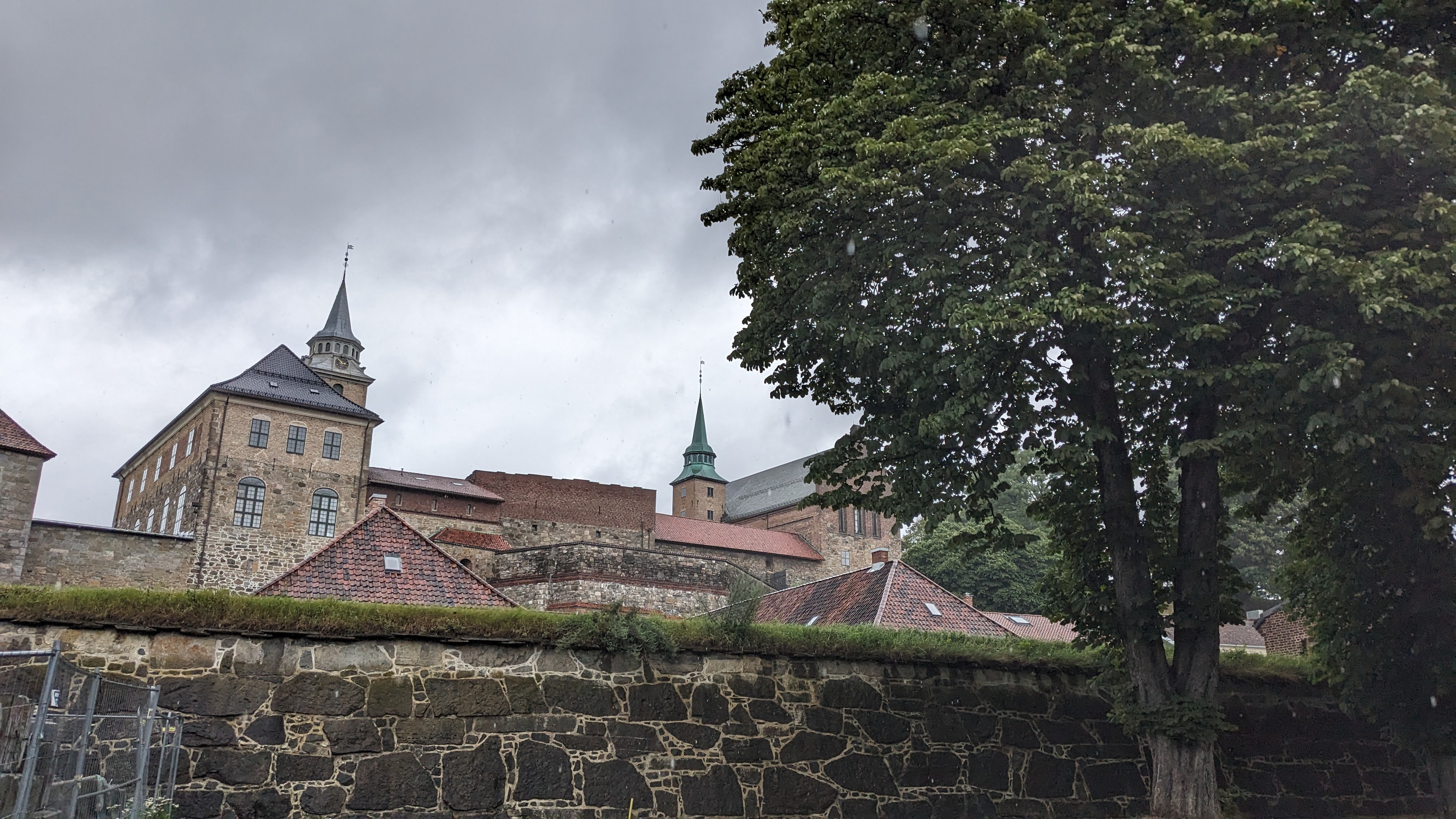
Akershus Fortress
Still hoping to try reindeer, Pat asked the hostess if they served it, or if she knew where we could get some. The hostess (who also functioned as the bartender) said that reindeer meat was not usually available until after the fall hunting season, but she told us that her brother, who was a chef at another restaurant, might know where to find some. She excused herself to go call him, but about ten minutes later reported that he couldn’t help, so we just sat down at a table and tried to make the best of a disappointing situation. Pat ordered a fish burger; Nancy and Michael had Reuben sandwiches—not exactly what we had had in mind when we started thinking about lunch today, but nothing else on the menu looked appealing. The meat and cheese were good, but the bread needed caraway seeds and we missed the kosher dill pickles typically served with Reubens in the U.S.
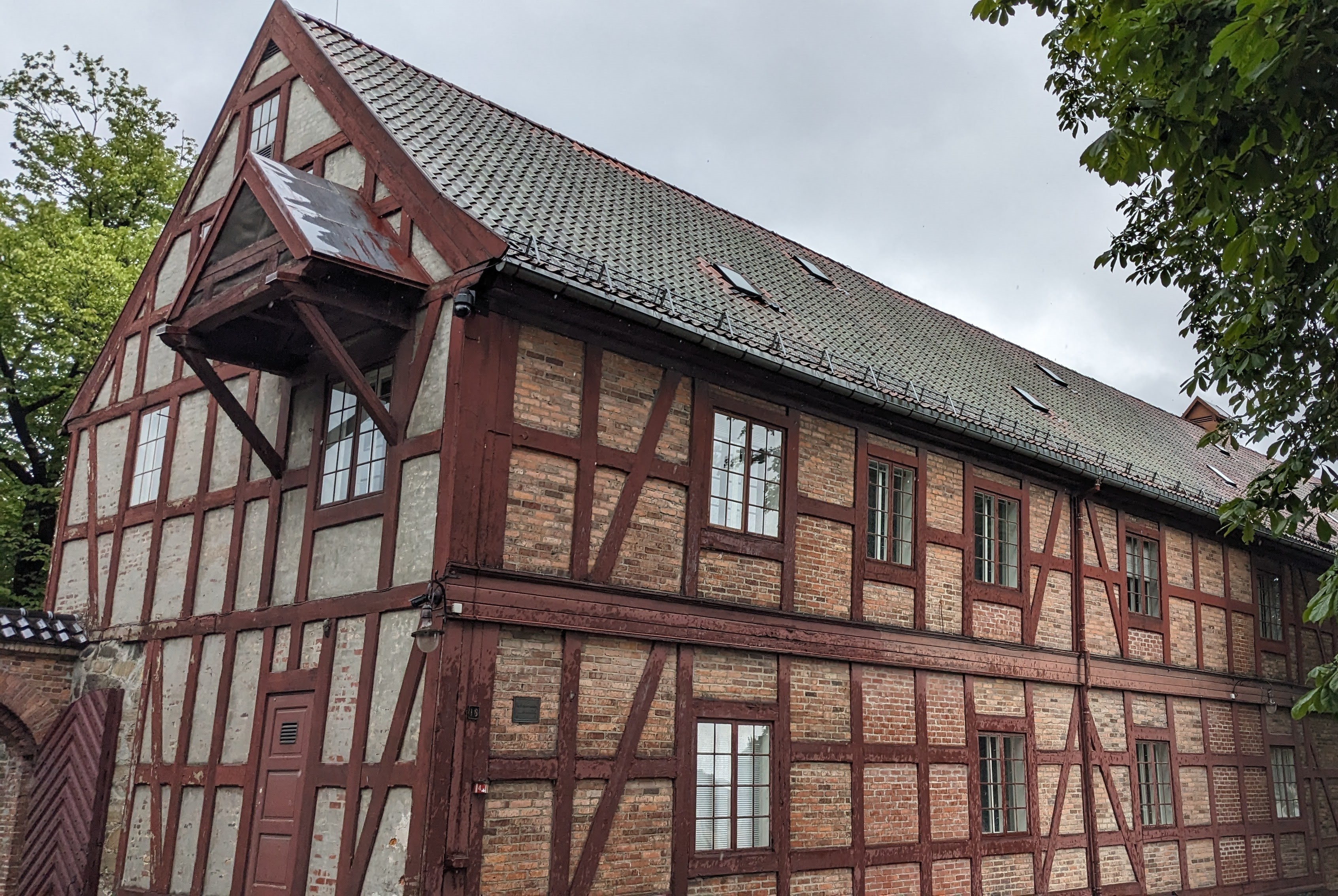
The current Akershus Visitors Center once was the Artillery
The plan for the afternoon was to visit Akershus Fortress and Castle, a medieval-era complex that has served as a military stronghold, a royal residence, and a prison at various times in its 750-year history. Hoping to gain control of Oslo’s strategic harbor, many Scandinavian noblemen sent their armies to besiege the fortress, but none ever succeeded in taking over the castle until the Germans invaded Norway in 1940. At that time, the Norwegian government fled Oslo, and Akershus Fortress fell to the Nazis without a fight. The complex wasn’t liberated until 1945. Today, Akershus houses the Norwegian Armed Forces Museum and the Norwegian Resistance Museum, as well as the Norwegian Ministry of Defense. It also contains a mausoleum where the remains of several kings, queens, and other royalty can be found.
We had hoped to visit Akershus after lunch, but it was raining so hard that we decided to just stay at the nearly-empty restaurant and take advantage of the wi-fi. About 45 minutes after we finished eating, Nancy got up to look out the windows and decided that the rain was finally subsiding. “Let’s go to the fortress,” she urged.
“It’s a twenty-minute walk,” Michael said. “We’d only have enough time to get there before we’d have to turn around and come back. We won’t have time to go inside any of the buildings.”
“Well, I’d rather go and at least see it than just sit here,” Nancy said, so Michael agreed to accompany her.
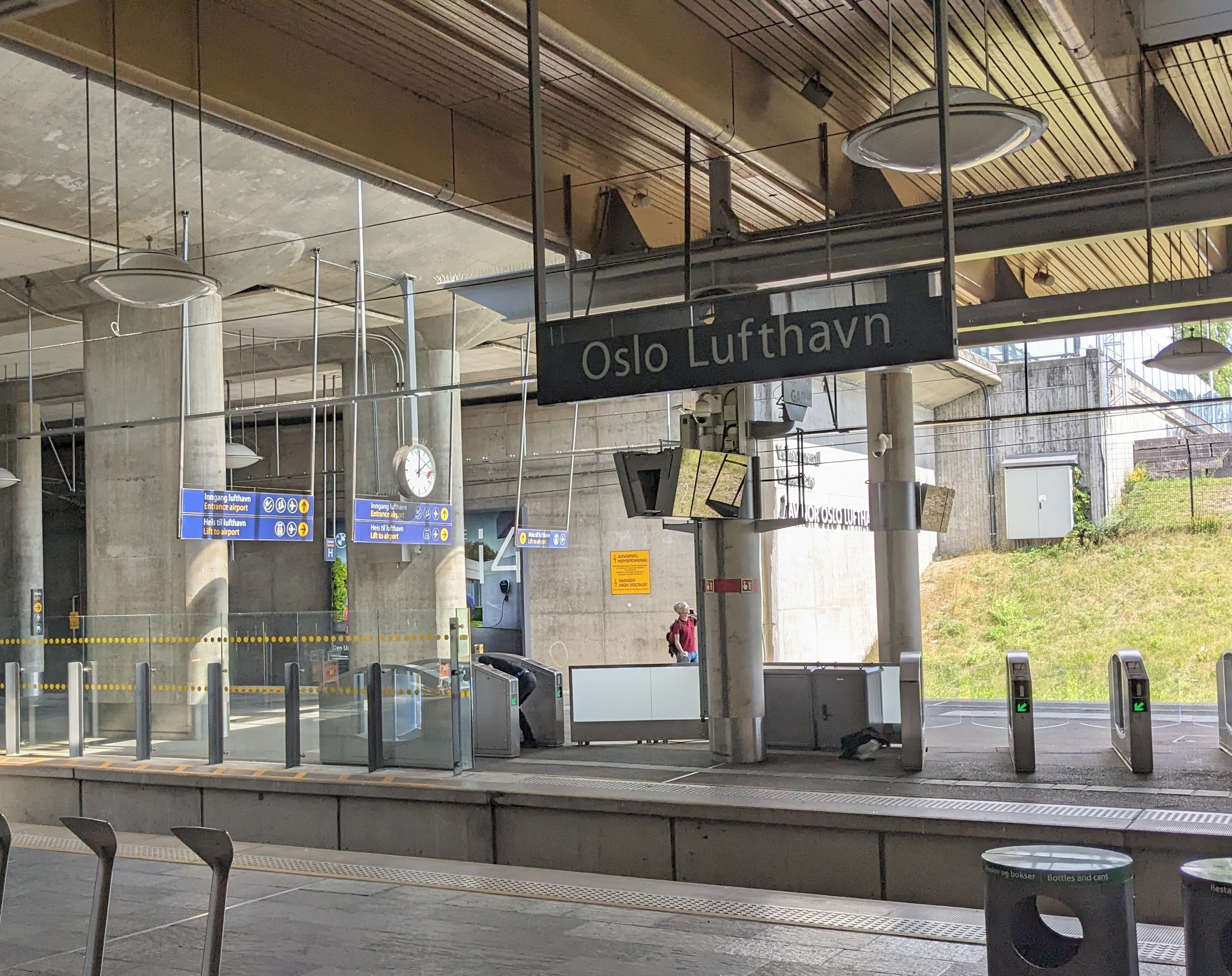
Flytoget platform
Pat didn’t have enough energy for more than a short walk, so since we had to return to the hotel to pick up our luggage, anyway, we left her in the lobby there to read while we took off for the fortress. It wasn’t long before Michael began wishing he had stayed with her; speed-walking on wet streets in slippery church shoes was not his idea of fun. We made it to the fortress, but Nancy had only enough time to snap a few photos before Michael insisted on turning back so we wouldn’t have to run. Retrieving Pat and our luggage, we hurried to the transit station and then stood on the platform for twenty minutes before the Flytoget that would take us to the airport arrived.

Haven salad bar
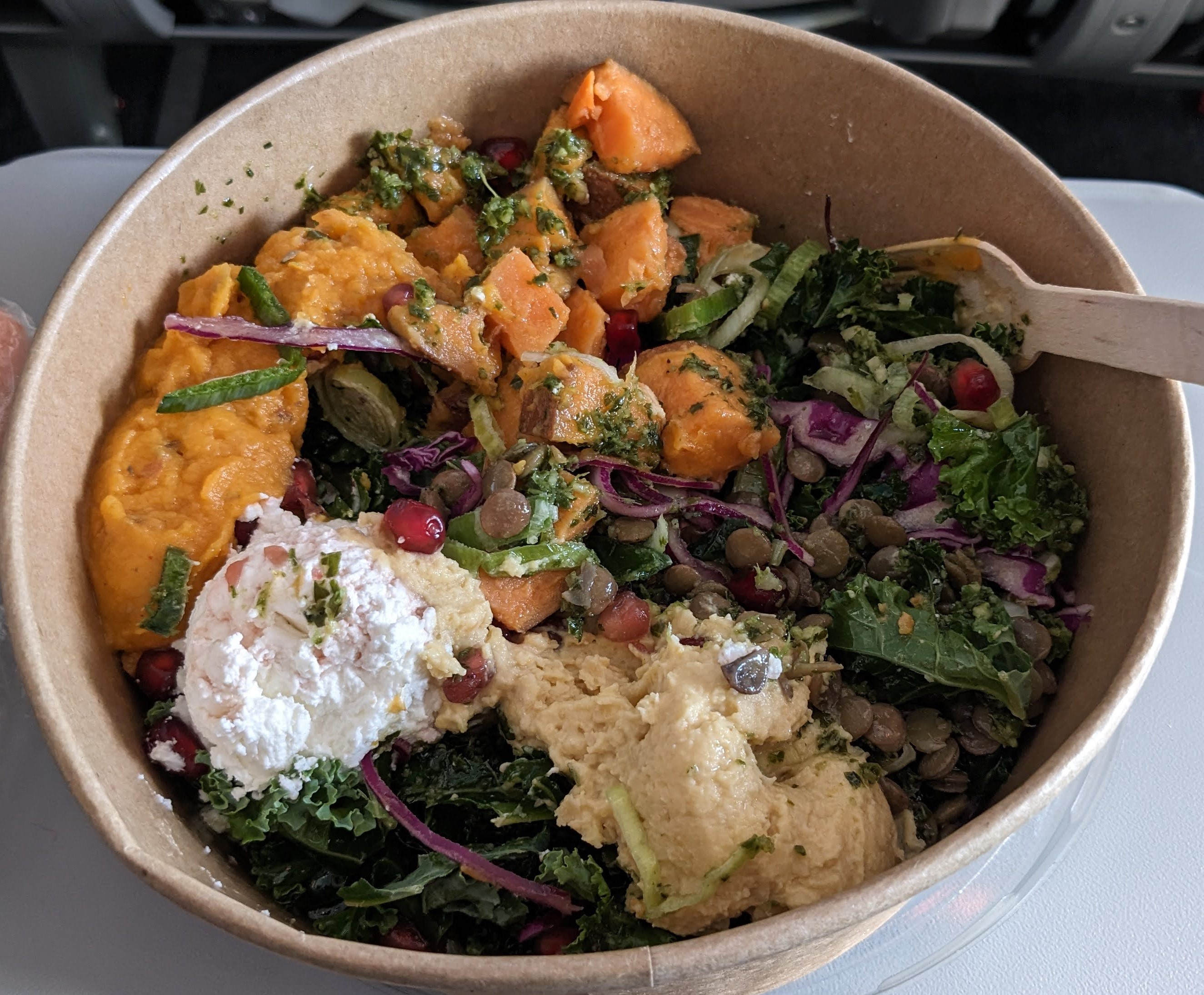
A meal in a bowl from Haven
Having had sandwiches for lunch, we decided to go back to Haven for build-your-own salads and pastries to take on the flight back to Paris. Besides eating the salads we had brought, we either read or dozed during our two and a half hours on the plane. Nancy finished The Secret Life of Sunflowers, a historical novel based on the life of Vincent VanGogh’s sister-in-law that might have been better had it not turned out to be the author’s first foray into something beyond romances.
By 10 p.m. we were in our rooms at the Holiday Inn Roissy at Charles de Gaulle Airport. Were we to do another “nutshell” tour of Norway, we would choose a larger-capacity shell: a coconut, maybe, rather than the tiny three-day pine nut into which we tried to cram everything from mountains to monuments to meatballs. But at least now we can say that we’ve been to Norway!
Thanks for sharing!
Love your travel posts